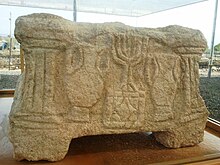Synagogue (Magdala)
The Synagogue of Magdala is the ruins of a synagogue in Migdal (Magdala) on the west coast of the Sea of Galilee , about 6 km north of Tiberias . According to the archaeologist Arfan Najar, it was built in the period 29 BC. Until about 68 AD, so probably during the lifetime of Jesus Christ .
excavation
The synagogue was discovered in 2009 during an emergency excavation because of the planned construction of a hotel. The archaeologists Dina Avshalom-Gorni and Arfan Najar led the excavation of the Israel Antiquities Authority .
description
The synagogue consisted of three rooms: a large, almost square reading room, which was adjoined by a vestibule in the west, and a smaller room in the south, which may have been used to store the scrolls. The floor in the vestibule consisted of tamped clay with limestone fragments. In the middle stood a square limestone block that may have served as the base for a chair or table. The floor around the cuboid was covered with basalt slabs.
A passage in the east wall of the vestibule led into the reading room. This had surrounding stone benches and in the middle a rectangular recess which was surrounded by two seating steps. Large areas of the mosaic floor with rosette and meander patterns were still preserved on the east side of the room. In places there was only the base made of small stones. In two corners of the recessed rectangle, larger fragments of basalt columns were found in situ , and another was on the floor. This was covered with small pounded stones, probably also the base for a mosaic. The columns and the walls of the room were covered with colored frescoes, which consisted of dark red, mustard yellow and blue areas between black and white frames.
Magdala Stone

A rectangular stone with four feet was set up in the reading room in the inner square. It has rich relief decorations on the surface and on the four sides. A seven-armed menorah is depicted on one side and is flanked by two amphorae and columns. The symbolic stone may have served as a table for the scroll in the reading room.
The stonemason, who remained unknown, created the relief possibly with knowledge of the Menorah in the Herodian Temple (29 BC to 70 AD) . The excavation leader Najar sees the stone as a symbol of the Herodian Temple at a time when it still existed.
literature
- Dina Avshalom-Gorni, Arfan Najar: Migdal - Preliminary Report . In: Hadashot Arkheologiyot - Excavations and Surveys in Israel , 125, 2013.
Web links
Individual evidence
- ^ A b Dina Avshalom-Gorni, Arfan Najar: Migdal - Preliminary Report .
- ↑ Welt.de of December 24, 2014
Coordinates: 32 ° 50 ' N , 35 ° 31' E
